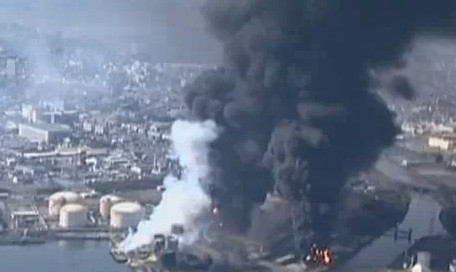Screen shot from Al Jazeera English coverage of the unfolding disaster
Russian nuclear accident specialist Iouli Andreyev, who helped with cleanup in the aftermath of Chernobyl, said on March 16, "The Japanese were very greedy, and they used every square inch of the space. But when you have a dense placing of spent fuel in the basin, you have a high possibility of fire if the water is removed from the basin." His comments came as Japan faces a growing nuclear disaster with nuclear reactors leaking and radiation plumes discharging into the atmosphere.
Andreyev put the blame on corporations and United Nations' International Atomic Energy Agency, saying they had "willfully ignor[ed] lessons from the world's worst nuclear accident 25 years ago to protect the industry's expansion." He condemned the nuclear industry for ensuring Chernobyl was not studied properly.
Japan has been scrambling to contain a nuclear catastrophe ever since an 8.9 earthquake struck last week. As of Wednesday, March 16, a helicopter was unable to drop water on "the most troubled reactor" in the country. Workers left the power plant briefly as radiation levels increased.
In 2007, twelve power companies "admitted to thousands of irregularities in reporting past problems." Japanese citizens began to resist the building of new nuclear reactors. They pushed for legal actions to suspend operations. Now, US State Cables released by WikiLeaks, which are being published by the Telegraph and The Guardian, further affirm that some sort of coverup has been going on.
A cable from 2006 details :
On March 24, the Kanazawa District Court ordered the Hokuriku Electric Power Company (Rikuden) to shut down operations at Unit Two of its Shika Nuclear Power Plant (NPP) due to safety concerns over its ability to withstand powerful earthquakes. A group of 135 plaintiffs from across the country filed the suit against Rikuden in May 2005, after the operator began trial operations, arguing that its anti-seismic design was insufficient and the advanced boiling water reactor (ABWR) design was inherently dangerous. The suit followed up on an earlier unsuccessful attempt to halt the construction of the new reactor. The plaintiffs pointed to a study commissioned by the GOJ's Earthquake Research Committee that concluded there was a two percent chance that an earthquake with a magnitude of 7.6 or higher could occur along the 44-kilometer long Ochigata fault, which runs near the NPP. The unit was built to withstand a magnitude 6.5 earthquake. The plaintiffs claimed that Unit Two was built to seismic specifications established more than two decades earlier and therefore posed a direct threat to their safety.
The judge believed, "if there was an accident at the plant due to a large earthquake," there was a possibility of a radiation accident occurring. The judge also said, "Rikuden had not taken into consideration an earthquake that may occur along the Ochigata Fault when building the new reactor." And, "the court argued that Rikuden's estimates of potential earthquakes in the area were too conservative" (although the court did not buy that the design was unsafe "citing lack of evidence").
Appearing to take the order seriously, Nuclear and Industrial Safety Agency (NISA) Director-General Kenkichi Hirose said, "I've never thought that a court would order the cessation of the plant's operation." However, NISA's International Affairs Office Director Michio Hashimoto said "NISA believes the reactor is safe and that all safety analyses were appropriately conducted. Thus, NISA did not move to shut down the reactor in question.
As a result, NISA saw no reason why Rikuden should shutdown Unit Two. NISA emphasized the fact that the court order was a result of a civil suit and did not "question the validity of the national regulations themselves through an administrative lawsuit." Rikuden continued to operate the reactor.
This isn't really a huge revelation, as many Japanese citizens are aware of the corruption between the nuclear industry and the government. The court order was covered in Japan media. The world has wondered why Japan was so intent on using nuclear power even though it is so susceptible to seismic disasters.
Key events that have plagued the nuclear industry are as follows:
1999 - Two workers killed in explosion at Tokaimura plant
2003 - 17 Tepco plants shut down over falsified safety records
2004 - Five workers killed by steam from corroded pipe at Mihama
2007 - Damage inflicted on Kashiwazaki plant from earthquake
Despite those incidents and disasters in the past, the country has been pushed to rely on nuclear due to a "lack of indigenous energy resources." A BBC report from July 17, 2007, shows the country has a few geothermal projects but no oil and very little coal.
On March 18, 2009, the high court overturned the order to have the plant shut down. The Japan Economic Newswire reported, "Presiding Judge Nobuaki Watanabe said, "We cannot recognize the specific dangers to residents being exposed to radiation due to an accident, as the assessments of active fault and seismic shaking are appropriate.'"
The judge added, "Safety measures taken by Hokuriku Electric Power Co. [Rikuden] against the No. 2 reactor of its nuclear power plant in the town of Shika in Ishikawa Prefecture are in line with the government's quake resistance guidelines, which were revised after the lower court ruling."
The plaintiffs pushing for the shut down reacted, "The court simply believed what Hokuriku Electric Power said and we can't accept it," and, "the ruling gives little consideration to the dangers of having nuclear plants in Japan, a seismically active country." A professor of science and history at Kyushu University stated, "The reliability of the new guidelines was called into question by the (Niigata) earthquake and it should have been assessed more skeptically"The ruling conforms to the recent trend of power suppliers underestimating fault plane activity. People won't be convinced that nuclear power plants are safe by this ruling." [And, on February 28 of this year, the plant in Shika was shut down for unplanned repair.]
(Note: You can view every article as one long page if you sign up as an Advocate Member, or higher).






